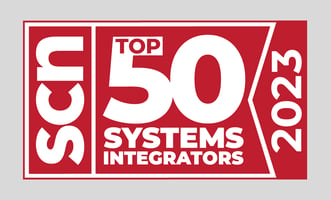FOR IMMEDIATE RELEASE [Chicago, Nov. 29, 2023] — ACP CreativIT, a leading provider of innovative...
On-premises or Cloud IT Infrastructure? Factors To Consider
When it comes time to decide between on-premises or cloud IT infrastructure, there is a lot to unpack. With on-premises IT infrastructure, your company’s server, storage, network, and backup equipment is hosted within your organization’s building, electrical, and heating/air conditioning infrastructure and is often physically onsite. This infrastructure is overseen by your company, or an IT partner and data is shared on the local network.

With cloud infrastructure, an outside service provider hosts your applications and data, and they procure, install, and maintain all hardware, software, and other supporting infrastructure in its data centers. Your applications and data can be accessed via the internet from various devices. Surveys have shown cloud IT infrastructure has been increasing in popularity and is often seen as the optimal choice. However, on-premises IT infrastructure does have advantages that are worth exploring. Join us as we take a closer look at each as they relate to several key determining factors.
Here are some considerations to help you choose between on-premises or cloud IT infrastructure.
Cost and Maintenance
- On-Premises - In the short term you will have to invest a large amount of capital initially on hardware, installation, software licensing fees, data backup, extra IT services, support and more. You will also need to invest in staff for support and consider energy costs, hosting costs, ongoing update fees, and extra square footage needed in your office space. With that being said, once you have built out the on-premises environment, there will be no ongoing cloud service subscription fees and your internet bills may be lower.
- Cloud - A monthly pay-as-you-go subscription fee means no large upfront costs. Cloud providers are responsible for maintenance, updating operating system software, security, and support. For some common applications, the vendor will also host the application as well (i.e., Software as a Service, also known as SaaS). For other applications, you may have to maintain the application itself. The more work that can be done by the cloud provider leaves more time for your staff to innovate and grow as opposed to troubleshooting problems.
Security/Threat Protection
- On-Premises - Companies that deploy an on-premises application often feel a sense of greater control since everything is onsite and there is no third-party provider that has access to it. The downside is you will be responsible for creating your own security system which requires a high level of expertise and constant monitoring.
- Cloud - Gartner estimates that 60 percent fewer security incidents have been recorded with the cloud as opposed to traditional data centers. Cloud security has never been better, and you will have a team of global cybersecurity experts making sure your information is always safeguarded. Please keep in mind that data and application security is still your company’s responsibility. A cloud provider may be able to assist and help, but your company must ensure that proper security is in place.
Compliance
- On-Premises - Specialized knowledge and expertise is required to stay compliant, and you must have the right employees and resources available to properly configure and maintain your systems to be compliant. If something goes wrong your business is responsible and you may be audited or fined.
- Cloud - Like security and threat protection, a cloud provider can assist with much of the compliance burden. Top cloud providers have teams of experts who have compliance certifications in a plethora of key industries including health, government, finance, education, manufacturing, and media. In the end, a breach in compliance is still your company’s responsibility and the burden of it still falls on your company’s shoulders. You should be vigilant about asking your cloud provider for audit results or compliance certificates and make sure all compliance requirements needed for your company’s applications and data are met.
Scalability
- On-Premises - Changing workloads must be met with added resources such as new hardware, software, electrical, heating/air conditioning, and backup IT infrastructure. Doing this requires costly resources and if the increased demand is short-lived your investment will be highly inefficient.
- Cloud - Workloads can be scaled as needed with only a few clicks using built-in features based on certain metrics. The flexibility to scale up or down as needed cuts overheads costs in comparison to monitoring and scaling resources manually. However, your application must be designed to be scalable to take advantage of these cloud scaling capabilities.
Performance
- On-Premises – Some companies find specially designed and optimized on-premises IT infrastructure is needed to meet the performance requirements of their applications. This could be caused by large data sets or applications that require high I/O or compute requirements.
- Cloud – Cloud providers have some ability to scale compute, ram, and storage. However, for some applications, this scaling is not sufficient to meet the required performance requirements.
Data Gravity
- On-Premises – Companies may have data that must be stored in their on-premises facilities for compliance, security, or performance reasons. Data gravity refers to related data sets that also need be stored locally so that the needed cross-referencing and/or integration of the data sets can be performed.
- Cloud – Data sets that can free stand and have no data gravity to locally hosted data sets are best suited for cloud storage.
Reliability
- On-Premises - Employees can fully access storage with no need for good internet network connection since internet access is not required. Placing all your data on the local IT infrastructure will limit access only to those physically in the office unless you also deploy remote access solutions. This could be a growing concern with the increasing number of remote workers. Also, the need for power, backup power, and a storage backup system should be recognized as costs that will need to be incurred.
- Cloud – The ability to access your files is at the mercy of your internet connection. No connection means no access and a slow connection can become extremely frustrating. A break in connectivity could cause a nosedive in productivity so it is critical to invest in a strong internet connection and you should even consider a backup connection.
Data Backup
- On-Premises – On-premises data storage means your company is at a greater risk of losing data in the event a major catastrophe strikes your facility. If you choose on-premises storage, an off-site backup service should be deployed to avoid data loss.
- Cloud – Cloud storage providers often come equipped with plenty of features to avoid data loss, such as built-in redundancy, failover, backup, automatic logging, and monitoring. In addition, recovery time is usually much shorter as compared to on-premises options.
Anywhere Access
- On-Premises – On-premises servers and storage can be a great choice if your workers are all in the same office and rarely mobile. Large files or videos are also better suited for on-premises server and storage because upload and download times will be shortened. It should be noted that unforeseen situations, such as the COVID-19 pandemic, that force your workers to go remote can overwhelm your remote access solution.
- Cloud – As long as you have internet you have access to everything you would in the office from anywhere. This may eliminate the need for VPN and remote access while also allowing for easy file sharing, real-time collaboration, and better version control. Differential sync may also be available to you which can lessen upload time and bandwidth when working with large files.
Choosing between on-premises or cloud IT infrastructure can be challenging because they come with their own benefits and downfalls. Perhaps the best answer is a hybrid solution where you can capitalize on the best of both worlds. Embracing a hybrid approach can improve your IT agility while maximizing efficiency. Greater flexibility and more deployment options become available when data and applications can move between on-premises servers and public clouds.
However, a hybrid solution is often seen as a temporary option. Studies show companies currently run about 43 percent of their workload in the public cloud. That number is only rising. Companies with IT departments that are understaffed and overworked find it hard to ignore the benefits of fully migrating to the cloud.
ACP CreativIT and CCCP are happy to help your organization decide on and deploy the best solution to meet your unique needs. Contact us to talk to one of our experts today.



.png?height=200&name=Untitled%20design%20(19).png)